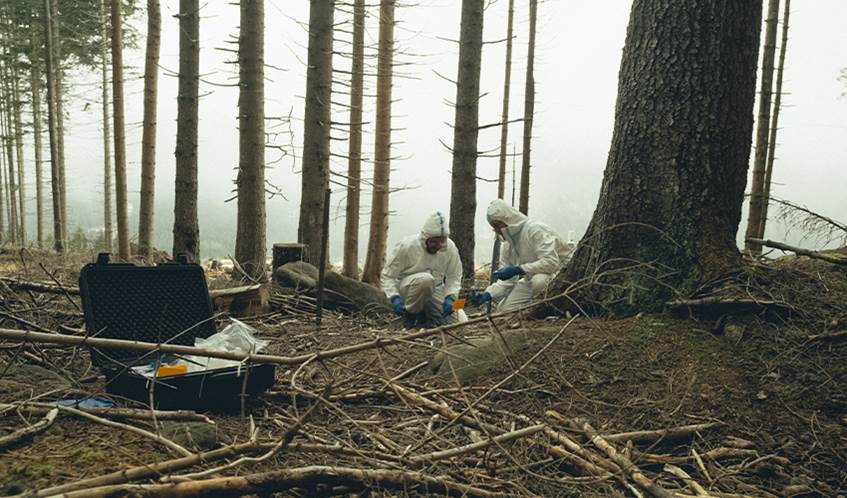Spruce trees communicate during a solar eclipse

An international team of scientists, led by UWE Bristol Visiting Professor Alessandro Chiolerio, has discovered that Norway spruce trees (Picea abies) can anticipate and collectively respond to a solar eclipse, through subtle changes in their electrical activity—detectable up to 14 hours before the event.
This surprising discovery, published in Royal Society Open Science, is part of the pioneering “Cyberforest Experiment”, which combines tools from quantum field theory, complex systems science, and biological signal analysis to explore how forests behave as coordinated, living networks.
The study was carried out in the Dolomites' Val di Fiemme (Trento) at 2,000 meters above sea level, where trees were continuously monitored before, during, and after a partial solar eclipse. Researchers observed that the electrical signals emitted by the trees began to synchronise well before the eclipse—a response that suggests trees may have anticipatory sensing abilities and can respond collectively to major environmental changes.
To study these phenomena, the team used advanced mathematical tools—such as Shannon entropy, fractal dimension, and diversity indices—commonly applied in fields like neuroscience and ecology. These revealed that the trees shifted from irregular, multi-patterned electrical signals to a more stable and coordinated rhythm during the eclipse. This shift points to a form of emergent organisation within the forest, resembling behaviours seen in self-organising systems.

The researchers also measured how the trees’ electrical signals aligned with each other using cross-correlation functions, which showed that pairs of trees developed changing patterns of synchrony over time. These findings align with the concept of spontaneous symmetry breaking, borrowed from quantum field theory, where systems transition to a more ordered state in response to external influence.
“Our results suggest that forests don’t just function as collections of individual trees, but as interconnected biological networks capable of sophisticated coordination, a so called holobiont,” said Prof. Chiolerio.
The research team emphasized that, despite the biological differences between plants and animals, the ability to respond collectively and coherently to environmental stress appears to be a shared survival strategy across life forms—one that may help entire ecosystems remain resilient in uncertain conditions.
Beyond its scientific significance, this study offers new ways to understand forests: not just as static ecosystems, but as active, responsive entities with internal organisation. These insights could influence climate adaptation strategies, forest management, and even inspire bioinspired technologies that model nature’s intelligence—bridging ecology, physics, and next-generation AIoT (Artificial Intelligence of Things).
Future research will explore whether this synchronisation helps forests withstand environmental stresses, potentially informing climate adaptation strategies and forest conservation efforts.
For further insights, the full paper is available via Royal Society Publishing.
Related news

25 November 2025
UWE Bristol experts join film Q&A exploring music and melodrama
Academics will take part in the Cary Comes Home Festival, with a post-screening Q&A exploring music, melodrama and emotional storytelling in classic cinema.

17 November 2025
Urgent reform needed to support ambulance-delivered end of life care, study finds
More than three quarters (78 per cent) of paramedics sometimes fear doing the wrong thing when caring for people in the last year of life, new research has found.

13 November 2025
Bristol’s screen industry experiences “boom-and-bust cycle” after post-pandemic recovery, new research from UWE Bristol finds
New research from UWE Bristol provides detailed insight into Bristol's screen sector.

13 November 2025
New AI research to revolutionise animal welfare
A UWE Bristol research project will combine behavioural science and AI to create technology that understands not only what animals do, but how they feel.

10 November 2025
Lessons from Low Traffic Neighbourhoods will drive better public engagement, study finds
Lessons from Low Traffic Neighbourhoods have informed a new toolkit to improve engagement with the public on challenging local street issues.

06 November 2025
First-of-its-kind study aims to help more people spend their final days at home
A new study will explore how architectural design could support end-of-life care in domestic settings.

29 October 2025
UWE Bristol academic unveils breakthrough in energy-efficient AI at NATO science forum
Dr Jonathan Lancelot has developed a new form of AI that could transform how intelligent machines operate in space, defence, and remote environments.

15 October 2025
UK food needs radical transformation on scale not seen since Second World War, new report finds
A new report from the Agri-Food for Net Zero Network+ finds urgent action on food is needed if the UK is to reboot its flagging economy, save the NHS billions, ensure national food security, and meet climate commitments.

07 October 2025
Academic playing role in project to find hidden graves in Mexico using drone technology
A UWE Bristol lecturer is playing a part in a project using drone technology to locate concealed graves in Mexico.

01 October 2025
New funding for researchers to develop trustworthy clinical AI for assessing brain activity
Researchers have received funding from UK Research and Innovation to help bring their innovative brain-monitoring AI technology closer to real-world use.

29 September 2025
Smartphone use hitting struggling pupils hardest, major study finds
Young people struggling with their studies at school are much more likely to have negative experiences on their smartphones than their better performing peers, a major new study has found.

16 September 2025
Dedicated liaison roles ‘instrumental’ for police forces to build trust with sex workers, research finds
A new study from UWE Bristol researchers has found that a dedicated liaison officer could help rebuild trust between the police and sex workers.
You may also be interested in

Media enquiries
Enquiries related to news releases and press and contacts for the media team.

Find an expert
Media contacts are invited to check out the vast range of subjects where UWE Bristol can offer up expert commentary.






